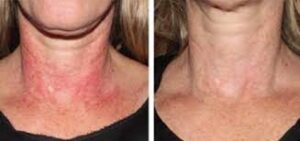POIKILODERMA
Poikiloderma is a condition that causes your skin to become discolored and break down. Doctors believe poikiloderma is a group of symptoms and not an actual disease.
Poikiloderma is a condition that causes your skin to become discolored and break down. Doctors believe poikiloderma is a group of symptoms and not an actual disease.

Poikiloderma can be caused or associated with a variety of diseases and conditions because it is a collection of symptoms rather than a disease.
General measures
Creams
Combination creams and lasers
This problem is frequently treated with a combination of creams and lasers. Initially, the goal is to cure and erase the brown spots (pigmentation) of poikiloderma. Lasers will be more effective in targeting the red spots once this has been accomplished
Laser and light therapies
Laser and light therapies provide the most promising method of treating poikiloderma.
Pulse dye laser(595nm):For the best results, most patients will need 3 to 6 sessions. Each treatment may cause minor bruising that lasts only a few days.The skin may become pale at first, and a “checkerboard” or patchy appearance may occur. However, once treatment is completed, these symptoms will go away.
Intense pulse light (IPL): This is a broad band light treatment that targets the treatment of both blood vessels and melanin (pigment) resulting in the reduction of redness and brown discoloration.Treatments are scheduled every 4 to 6 weeks. With IPL, there will be noticeable “foot printing,” however with many sessions, this appearance can be improved.
Fractional non ablative lasers (1927 nm):These lasers target several components of poikiloderma.2 to 4 treatments are required for the best possible outcome.
The laser produces a high-intensity light beam that is converted into heat energy. Because cells with an excessive concentration of pigmentation absorb the energy created by the laser, the heat energy is directed at a specific area of pigmentation. Poikiloderma laser treatment can result in a significant reduction in the visual features of the disorder after several treatment sessions.